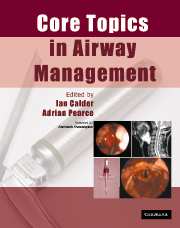Book contents
- Frontmatter
- Contents
- List of contributors
- Preface
- Acknowledgements
- List of abbreviations
- 1 Anatomy
- 2 Physiology of apnoea and hypoxia
- 3 Physics and physiology
- 4 Cleaning and disinfection of airway equipment
- 5 General principles
- 6 Maintenance of the airway during anaesthesia: supra-glottic devices
- 7 Tracheal tubes
- 8 Tracheal intubation of the adult patient
- 9 Confirmation of tracheal intubation
- 10 Extubation
- 11 Light-guided intubation: the trachlight
- 12 Fibreoptic intubation
- 13 Retrograde intubation
- 14 Endobronchial and double-lumen tubes, bronchial blockers
- 15 ‘Difficult airways’: causation and prediction
- 16 The paediatric airway
- 17 Obstructive sleep apnoea and anaesthesia
- 18 The airway in cervical trauma
- 19 The airway in cervical spine disease and surgery
- 20 The aspiration problem
- 21 The lost airway
- 22 Trauma to the airway
- 23 Airway mortality associated with anaesthesia and medico-legal aspects
- 24 ENT and maxillofacial surgery
- 25 Airway management in the ICU
- 26 The airway in obstetrics
- Index
14 - Endobronchial and double-lumen tubes, bronchial blockers
Published online by Cambridge University Press: 15 December 2009
- Frontmatter
- Contents
- List of contributors
- Preface
- Acknowledgements
- List of abbreviations
- 1 Anatomy
- 2 Physiology of apnoea and hypoxia
- 3 Physics and physiology
- 4 Cleaning and disinfection of airway equipment
- 5 General principles
- 6 Maintenance of the airway during anaesthesia: supra-glottic devices
- 7 Tracheal tubes
- 8 Tracheal intubation of the adult patient
- 9 Confirmation of tracheal intubation
- 10 Extubation
- 11 Light-guided intubation: the trachlight
- 12 Fibreoptic intubation
- 13 Retrograde intubation
- 14 Endobronchial and double-lumen tubes, bronchial blockers
- 15 ‘Difficult airways’: causation and prediction
- 16 The paediatric airway
- 17 Obstructive sleep apnoea and anaesthesia
- 18 The airway in cervical trauma
- 19 The airway in cervical spine disease and surgery
- 20 The aspiration problem
- 21 The lost airway
- 22 Trauma to the airway
- 23 Airway mortality associated with anaesthesia and medico-legal aspects
- 24 ENT and maxillofacial surgery
- 25 Airway management in the ICU
- 26 The airway in obstetrics
- Index
Summary
Thoracic surgical operations require the anaesthetist to be able to cease ventilation and allow deflation of the operative lung, to protect the lower lung from contamination with blood, tumour or infective material and to continue ventilation of the non-operative, dependent lung. Without the ability to separate and independently ventilate the lungs, thoracic surgery is hazardous. The first planned pulmonary resection by Block on a young female relative in 1883 was a disaster. She died on the operating table and Block committed suicide. A major component of safe thoracic anaesthesia is the appropriate use of endobronchial tubes, double-lumen tubes (DLTs) and bronchial blockers. Indications for their use are not restricted to pulmonary surgery and there are other clinical indications for lung separation (Table 14.1).
Endobronchial tubes
The First attempts at selective lung ventilation were with endobronchial tubes. These long, single-lumen tubes were placed in the bronchus of the dependent, non-operative lung. The classical technique, devised by Magill, was to load the tube onto a rigid intubating bronchoscope and place the tube under direct bronchoscopic view. It was possible to ventilate both lungs at the end of surgery by withdrawing the endobronchial tube into the trachea. The technique of one-lung ventilation by endobronchial placement of a single-lumen tube is still in practice in specialized circumstances, usually with blind or fibreoptic positioning into the appropriate bronchus. The next development was of a combined tracheal tube and bronchial blocker (Macintosh–Leatherdale). This tube consisted of a standard tracheal tube and a cuffed blocker limb which entered the bronchus of the operative lung. Both lungs could be ventilated when the blocker cuff was deflated, and subsequent inflation of the cuff would isolate the operative lung.
- Type
- Chapter
- Information
- Core Topics in Airway Management , pp. 109 - 112Publisher: Cambridge University PressPrint publication year: 2005



